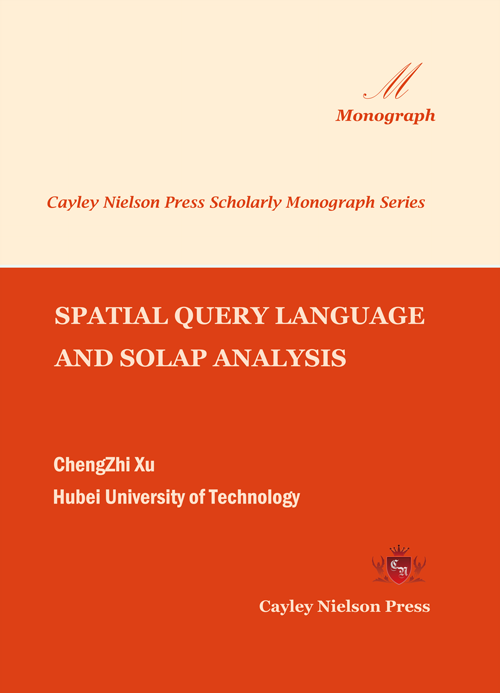
SPATIAL QUERY LANGUAGE AND SOLAP ANALYSIS

ChengZhi Xu
Hubei University of Technology
Copyright © 2019 by Cayley Nielson Press, Inc.
ISBN: 978-1-5323-9660-1
Cayley Nielson Press Scholarly Monograph Series Book Code No.: 209-6-4
US$210.50
Preface
Fast growing of spatial information and the complexity is far beyond the capacity of people's interpretation. Although spatial database enables data input, changes, statistics, queries and other functions, but can not effectively find out hidden in the back of the relations between spatial data, rules and trends and other features, which results situation of “Spatial data rich, space knowledge poor”. Therefore, from the spatial database automatically mining knowledge, to find not clear, implicit knowledge, spatial relations, or other modes becomes increasingly important. Content of this book started at spatial query language, and then deeply researched on space online analytical processing and spatial association rules.
According to the characteristics of spatial data, this book proposed a new spatial query language, Semantic Query Description Language for Geography (SQDL-G), based on GIS. The language converts spatial predicates into spatial operators and introduces sub-query structure. The language can express complex spatial query expression, and have a better efficiency than traditional query language. With the support of spatial query language, this book studied on the initial stage of spatial data mining - Space online analytical processing (SOLAP). Cooperating with spatial query language (SQDL-G), SOLAP system introduces factor objects and surrounding things into data cubic to setup main spatial dimensions and auxiliary spatial dimensions. Multi-spatial-dimension SOLAP makes full use of topology ability of GIS, materializes spatial relation between objects, and enhances analysis ability of SOLAP.
Overall, this book made a useful spatial data mining exploration and research. Rich semantics to express a variety of spatial query language SQDL-G, with the construction of multi-dimensional data cube of space making spatial data mining and knowledge discovery become standardized and engineering.
Chengzhi Xu
Hubei University of Technology
Wuhan, Hubei, China
October 10, 2019
Contents
Preface......................................................................................................... 1
1 Overview of Spatial Analysis................................................................... 5
1.1 Research Background............................................................................ 5
1.2.1 Characteristics of Structure............................................................... 5
1.2.2 Research Background of Spatial Data Mining................................... 9
1.2 Forth A Question................................................................................. 13
1.3 The Main Contents of This Book......................................................... 13
2 Spatial Data and GIS System................................................................. 15
2.1 Spatial Data......................................................................................... 15
2.2.1 Spatial Data Model.......................................................................... 15
2.1.2 Spatial Data Characteristics............................................................ 23
2.1.3 Spatial Reference System and Map Projection................................ 25
2.1.4 Data Transfer Model........................................................................ 27
2.2 Geographic Information System.......................................................... 31
2.2.1 Summary of GIS System................................................................... 31
2.2.2 Development of GIS......................................................................... 32
2.2.3 Spatial Database.............................................................................. 34
2.2.4 Spatial Topological Relations.......................................................... 36
2.3 Summary.............................................................................................. 40
3 Spatial Query Language SQDL-G......................................................... 41
3.1 Spatial Query Language...................................................................... 41
3.2 International Standard for the Language............................................ 43
3.2.1 SFA SQL and SQL/MM Spatial........................................................ 43
3.2.2 Oracle Spatial.................................................................................. 46
3.3 Existing Problems................................................................................ 51
3.4 Spatial Operator and Subquery........................................................... 55
3.5 Syntax of SQDL-G............................................................................... 59
3.6 Spatial View in SQDL-G..................................................................... 68
3.7 Equivalent Conversion of SQDL-G..................................................... 72
3.8 Implementation of SQDL-G................................................................ 75
3.8.1 Compile SQDL-G............................................................................. 76
3.8.2 Execution of SQDL-G....................................................................... 82
3.9 SQDL-G and Map Search................................................................... 89
3.10 Summary............................................................................................ 91
4 SOLAP Analysis of Multi-Spatial Dimensions....................................... 92
4.1 Data Warehouse and SOLAP.............................................................. 92
4.2 Development History of SOLAP.......................................................... 93
4.3 Multidimensional Data Cube Based on GIS Platform........................ 97
4.3.1 Multidimensional Data Cube........................................................... 97
4.3.2 Quantification of Spatial Relations................................................ 100
4.4 SOLAP Operations for Multidimensional Models............................ 105
4.4.1 Generalization of Spatial Dimensions............................................ 105
4.4.2 SOLAP Operation........................................................................... 108
4.5 The Number of Spatial Dimensions................................................... 110
4.6 SOLAP Data Model: Star, Snowflake and Constellation.................. 113
4.7 Layers and Spatial Dimensions......................................................... 116
4.8 SOLAP Server.................................................................................... 117
4.9 Case Study......................................................................................... 119
4.10 Summary.......................................................................................... 128
5 Summary and Prospect......................................................................... 129
5.1 Summary............................................................................................ 129
5.2 Prospect............................................................................................. 131
References............................................................................................... 135
Readership
This book should be useful for students, scientists, engineers and professionals working in the areas of optoelectronic packaging, photonic devices, semiconductor technology, materials science, polymer science, electrical and electronics engineering. This book could be used for one semester course on adhesives for photonics packaging designed for both undergraduate and graduate engineering students.
